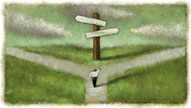 There are certain questions which are commonly asked as if they had only either/or answers. Some of these questions are better answered with “it depends”—as long as we’re clear about on what it depends. So it is with the classic “do they buy the professional or the firm” question.
There are certain questions which are commonly asked as if they had only either/or answers. Some of these questions are better answered with “it depends”—as long as we’re clear about on what it depends. So it is with the classic “do they buy the professional or the firm” question.
Most (though not all) clients are inclined at first inclination to say they buy the lawyer. After further reflection, most then say they do both—in different ways, for different reasons, under different circumstances. This note tries to explains the “depends” clause.
Most models of buying decision-making portray a linear, rational sequence of cognitive thought. They begin with problem clarification and definition, then proceed to outlining alternative solutions—including contracting for legal services—and move on to defining criteria for selection, then to matching facts against those criteria. But this doesn’t fully describe how clients really buy.
How Clients Really Buy Legal Services
The real decision process is not completely rational, nor entirely linear. But most importantly, it covers two distinct phases—screening and selection. Screening usually comes first, and is heavily focused on the firm. Selection usually comes second, and is heavily focused on the lawyer.
Therefore it is generally important to market the firm in the screening process, and to sell the lawyer in the selection process.
In the classic example of a client seeking new counsel, Figure 1. below outlines this principle.
| Figure 1. The New Counsel Buying Process |
 |
In the new counsel buying process, a client begins with screening. The client puts together an initial “short list,” based on some combination of prior experience, reputation, recommendations, and some initial search. It is here that marketing programs based on the firm have their greatest impact.
Having gone through the screening process—even if only one firm emerges as likely to be viable—most clients insist on some kind of personal interaction before making a decision. And usually this selection process involves several firms. Selection may be more or less formal, may involve presentations or phone calls, but in almost all cases involves personal interaction.
Following are some distinctions between the screening and the selection processes.
| Figure 2. New Counsel Selection Process | ||
| Screening | Selection | |
| Nature of process | Rational, analytical | Emotional, personal |
| Outcome | Narrowing down | Decision |
| Typical criteria | Competence, scale, geography, industry | Trust, fit, inter- personals, values |
| Typical venue | Written, or structured | Personal, interactive |
| Key law firm function | Marketing | Personal selling |
| Key client question | “Can they do it?” | “Can I work with them?” |
Working the Two Processes
Perhaps the most common mistake made by law firms is to continue behaving as if they are in the screening process when it comes time to work the selection process. A great deal of the screening process is done at a far remove—through promotional materials available in print or on websites, through industry sources, through third-party references, and through initial rather scripted inquiry phone calls. The best screening materials consist of concise statements of focus, and objective referent points of competence.
 Once past screening, the game changes utterly. The interaction becomes personal. Suddenly, the client is no longer interested in hearing dry statistical information—even if he says otherwise. When meeting in person for the first time, clients behave like every other human being; we all begin very rapidly to form very strong perceptions. Here the lawyer sells himself—but a paradox arises. You sell yourself not by talking about yourself, but by talking about the client.
Once past screening, the game changes utterly. The interaction becomes personal. Suddenly, the client is no longer interested in hearing dry statistical information—even if he says otherwise. When meeting in person for the first time, clients behave like every other human being; we all begin very rapidly to form very strong perceptions. Here the lawyer sells himself—but a paradox arises. You sell yourself not by talking about yourself, but by talking about the client.
The critical issue in the selection process, then, is for counsel to stop reciting its own expertise—whether the firm or the lawyer’s—and to apply it to the client’s own issues.
This approach to selling viscerally role-models client-focus to a client. It also makes tangible for the client the real abilities of counsel, or lack thereof. The good news about this kind of selling is that it is far closer to “doing” than some dreamed-of idea of “selling”—and thus it is far more comfortable for professionals who feel “selling” is faintly unprofessional.
Exceptions to the Two-Process Rule
When a client has a strong existing relationship with counsel and sees the need for a new matter, he or she almost unconsciously thinks first, “can my existing counsel handle this matter?” If so, the 2-step process is usually cut short, and the business given to the existing firm. For most clients, there is a strong inclination to “not fix what ain’t broke.”
Other exceptions to the rule include:
- clients where corporate policy dictates multiple vendor relationships
- clients who are extremely averse to relying on personal “feel” to make selection processes, and who therefore treat selection like screening
- clients where pre-existing external relationship exist, and where sham processes are therefore constructed to give the appearance of objectivity and hide “wired” decisions.
But these are relatively uncommon. In general, law firms are well advised to:
- marketthefirm in ways that help clients screen, and
- sell the individual in ways that help clients make selections.
